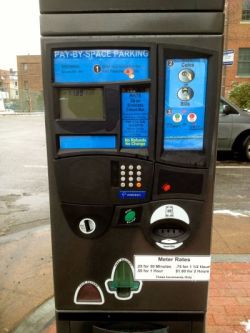Do you notice when things you use are badly designed? Or do you think that you just need to pay more attention to learn what to do?
My local library has an automated kiosk where people pay for parking spaces. New users must study the machine to figure out what to do. Even people who have used it before seem to need retraining before they can get a ticket each time.
 Why is this? Well, there are lots of little “things” on the machine — panels, words, slots, buttons, and sliding doors, and it’s hard to see what is important and what belongs with what. There is a high ratio of noise to signal.
Why is this? Well, there are lots of little “things” on the machine — panels, words, slots, buttons, and sliding doors, and it’s hard to see what is important and what belongs with what. There is a high ratio of noise to signal.
Nearly everyone has had the experience of thinking “does it have to be this difficult?” in learning about a new parking payment kiosk, copying machine or other product. Yet as one gets to know a device well, the feeling fades. In fact, often people believe that if they learned how to use it, everyone else should have to put in the same amount of work to figure it out.
I love the title of a book by Steve Krug about web design: Don’t Make Me Think. The examples in my 2000 copy of the book look dated now because of the great changes in digital technology since then. But the ideas about design remain true. The best designs require less attention to unimportant details. Better design lets us concentrate on what is important.We shouldn’t have to think about extraneous junk.
Junk is not necessarily bad. Junk may be interesting. We may be able to make other things from junk. Junk might even be treasure in another situation. However, the nature of junk is that it is unnecessary to our immediate purposes. If crucial information is hidden by junk or replaced with junk, we have a problem.
What is junk in teaching? If it’s junk, it’s unnecessary for understanding our particular subject. If we choose to do something, we should know what we are doing and why, and so should our students. What we include in our lessons may be fun, imaginative, or thought-provoking, all of which can help direct attention to what IS important. Then it probably ISN’T junk. But often junk is just added stuff to do. At its most detrimental, junk is noise — anything that hides or confuses what is most important, essential, and meaningful about a subject.
Some of my other posts describe things that are often asked of students that interfere with accurate or efficient learning in reading and math. Here are a few examples of everyday junk in classrooms:
- Worksheets with titles like “Fun with Fractions” or whatever the topic is. Titles and headings are supposed to call attention to what is important. Titles like this lead to children ignoring titles. Children may also think that their teachers are fools or liars, although teachers usually are only using materials that are readily available. Fractions can be fascinating, but usually any worksheet that is titled fun probably is only a failed math public relations ploy.
- Telling children to always keep their eyes on the teacher while she’s talking.* Some better ways to keep all children’s attention are to require them to take notes on answers to specific questions — which could even be drawings — or to have them respond in some overt way (holding up card with choice, thumbs up or down for yes or no, or written response and sharing with partner) after each few minutes to a question that requires them to make a decision about what has been said. Seeing other children at work also helps develop an environment of attention to what is important.
- Activities that require children to follow demanding directions that have nothing to do with learning what needs to be learned. For example, I’ve seen worksheets that ask kids to sequence long lists of sentences into paragraphs about things that they don’t know about. If children are learning about sequencing information, they should start with a few sentences at a time about something they already know about.
You probably have your own examples.
Junk also includes the assumptions and beliefs that keep us from recognizing the junk that we accept in education. Education is big business. If one pays attention only to what is said about educational materials and methods instead of looking at them directly and measuring what actually happens when they are used, it is easy to let junk slip by. If something has been used long enough, it is even possible to believe that it is crucial for learning.
Unless we look carefully.
*Some of the best online learning classes show the teacher infrequently and thoughtfully, for particular purposes. Similarly, some of the most informative and even emotionally moving nature, science, and history documentaries have narrators that are unseen. The focus always has to be on what is most important.
- My Xyla and Yabu App: Are the Word Problems Too Much? - September 24, 2016
- Model Drawing — An Essential Tool that Makes Us Smarter - September 9, 2016
- To What Should We Have to Pay Attention? - October 2, 2014